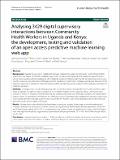Analysing 3429 Digital Supervisory Interactions Between Community Health Workers in Uganda and Kenya: The Development, Testing and Validation of an Open Access Predictive Machine Learning Web App
View/
Publication Date
2022-03Type
Article, Journalviews
downloads
Metadata
Show full item recordCitation
O’Donovan, J., Kahn, K., MacRae, M. et al. Analysing 3429 digital supervisory interactions between Community Health Workers in Uganda and Kenya: the development, testing and validation of an open access predictive machine learning web app. Hum Resour Health 20, 6 (2022). https://doi.org/10.1186/s12960-021-00699-5
Abstract/
Background: Despite the growth in mobile technologies (mHealth) to support Community Health Worker (CHW) supervision, the nature of mHealth-facilitated supervision remains underexplored. One strategy to support supervision at scale could be artificial intelligence (AI) modalities, including machine learning. We developed an open access, machine learning web application (CHWsupervisor) to predictively code instant messages exchanged between CHWs based on supervisory interaction codes. We document the development and validation of the web app and report its predictive accuracy. Methods: CHWsupervisor was developed using 2187 instant messages exchanged between CHWs and their supervisors in Uganda. The app was then validated on 1242 instant messages from a separate digital CHW supervisory network in Kenya. All messages from the training and validation data sets were manually coded by two independent human coders. The predictive performance of CHWsupervisor was determined by comparing the primary supervisory codes assigned by the web app, against those assigned by the human coders and calculating observed percentage agreement and Cohen’s kappa coefficients. Results: Human inter-coder reliability for the primary supervisory category of messages across the training and validation datasets was ‘substantial’ to ‘almost perfect’, as suggested by observed percentage agreements of 88–95% and Cohen’s kappa values of 0.7–0.91. In comparison to the human coders, the predictive accuracy of the CHWsupervisor web app was ‘moderate’, suggested by observed percentage agreements of 73–78% and Cohen’s kappa values of 0.51–0.56. Conclusions: Augmenting human coding is challenging because of the complexity of supervisory exchanges, which often require nuanced interpretation. A realistic understanding of the potential of machine learning approaches should be kept in mind by practitioners, as although they hold promise, supportive supervision still requires a level of human expertise. Scaling-up digital CHW supervision may therefore prove challenging. Trial registration: This was not a clinical trial and was therefore not registered as such.
Subject/
Machine learning; Artificial intelligence; Supervision; Community Health Worker (CHW); Digital Health; Training
Further Details
© The Author(s) 2022. Open Access This article is licensed under a Creative Commons Attribution 4.0 International License, which permits use, sharing, adaptation, distribution and reproduction in any medium or format, as long as you give appropriate credit to the original author(s) and the source, provide a link to the Creative Commons licence, and indicate if changes were made. The images or other third party material in this article are included in the article’s Creative Commons licence, unless indicated otherwise in a credit line to the material. If material is not included in the article’s Creative Commons licence and your intended use is not permitted by statutory regulation or exceeds the permitted use, you will need to obtain permission directly from the copyright holder. To view a copy of this licence, visit http:// creat iveco mmons. org/ licen ses/ by/4. 0/. The Creative Commons Public Domain Dedication waiver (http:// creat iveco mmons. org/ publi cdoma in/ zero/1. 0/) applies to the data made available in this article, unless otherwise stated in a credit line to the data.

